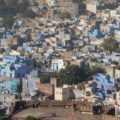A Sufi Music Festival Resounds in Nagaur
Thanks to an enterprising Maharajah, spirited travelers can take a magical journey back in time to one of India’s most ancient forts for a royal celebration of art, music and culture.
Searching for lost worlds of a bygone era? Don’t miss the next Nagaur Sufi Music Festival, held annually since February 2008, in Rajasthan, India. This growing festival recently celebrated its 3rd year and the meticulous restoration of the historic 12th Century Fort of Nagaur–an impressive desert fantasy of painted palaces and Rajput-Mughal water gardens and fountains. (No mean feat in the arid desert of Rajasthan!) Nagaur’s historic strategic location as a vital point of both trade and defense of the region, lends itself equally to the present context of tourism, located 135km north of Jodhpur and within the popular tour circuits of Jodhpur, Shekhawati, Bikaner and Jaisalmer.
Well known as a Sufi pilgrimage centre, Nagaur has several important tombs, mosques and shrines, and was once home to Sufi Hamiduddin Tarkin Sahib who was a close disciple of the renowned Sufi saint Hazrat Khwaja Moinuddin Chisti of Ajmer. Thus it was declared by the current Maharajah of Jodhpur (HH Gajsingh 11 of Marwar-Jodhpur) that the on-going restoration work of the Fort should be celebrated with the revival and re-creation of a Durbar of Sufi Music at Nagaur, most especially in memory of the Sufi Saint Nagauri. This unique annual event has enjoyed the support of the finest Sufi performers from all over India, Turkey, Iran, Egypt and Jordan–their mesmerizing performances transcending the man-made divides of class, caste, language, gender, history, geography and religion. Together, they have re-kindled the tradition of Sufism at Nagaur, and the festival is now typically held in mid-late February according to the status and auspicious placement of the moon. These festivities have enabled both international visitors and local residents alike to rejoice in their city and it’s world-class cultural heritage.
The Fort of Nagaur was among several historically important properties inherited by The Maharajah of Jodhpur upon the death of his father in 1952. At that time, aged just four years, he was installed as the new Maharajah, under the care of his father’s closest and wisest advisors until he came of age. (Images of him as a little boy presiding over state events of unimaginable grandeur are to be seen among intriguing family photos throughout his forts and palaces in Jodhpur reminding visitors of this powerful heritage.) Today, thanks to the Maharajah’s passion for his patrimony, and his own personal investment in it through the Mehrangarh Trust Museum of Jodhpur– generously supplemented by the Getty Foundation, the Helen Hamlyn Trust, and “Friends of Nagaur”–this remarkable royal camp, officially called Ahhichatragarh, but known as the monumental and magical Fort of Nagaur, has been magnificently retrieved for the 21st Century.
Now recognized as a must-see destination for the world’s most discerning travelers to India, the fort and Sufi music festival are attracting rock stars and royalty to commune within the crenellated walls of this historic monument and its surrounds. It was here in the Royal Jodhpur Camp that Liz Hurley’s guests were accommodated for her nuptials to Arun Nayar, and where Sting comes for inspiration, as he recently did with his wife Trudy Styler. Now you can too!
Guests reside in romantic tents hand-made in the traditional “Shikar” style that come with all the basic creature-comforts: running-water bathrooms, heating, verandahs, as well as your own personal man-servant, standing attentively on guard for the duration of your stay, deputized to take care of your every possible need with the utmost discretion.
In addition to the tented city, and thanks to the painstaking restoration of the entire Fort under the meticulous eye and expertise of the Project Director and architect Minakshi Jain, guests can now also experience living within the original eighteenth century environment of the Nagaur Fort in the previously ruined Ranvas Havelis. These re-instated apartments were originally built to house (in some splendor) the many Queens of the Mughul rulers. It was within these gem-like palaces and their environs that the royal ladies of Nagaur waited for their Kings to return for comfort and solace in between their constant warring to protect the region from their enemies.
The restoration work undertaken by Mrs. Jain and her team (all distinguished scholars, craftsmen, including several young graduates of the Courtauld Institute in London) is of such remarkable quality that it has been internationally acclaimed, winning the Award of Excellence for Cultural Heritage Conservation presented by UNESCO and also for citation in the Hadrian Award given to The Maharajah of Jodhpur himself in 2006.
The painted walls and ceilings of the palaces of Nagaur are of immense importance to historians, scholars and astute travelers alike as they intimately show the way of life enjoyed there in the 17th-18th centuries. Recently, paintings from the private collection of the Maharajah were displayed for the first time publicly in a memorable exhibition: GARDEN & COSMOS – the Royal Paintings of Jodhpur, initially organized by the Arthur M. Sackler Gallery at the Smithsonian in Washington and later seen at The British Museum in London in the summer 2009, and the NSW Art Gallery in Sydney, in December 2009. These paintings, generously on loan from the Mehrangarh Museum Trust in Jodhpur, had previously been kept under lock and key in careful conserving circumstances in Jodhpur, and have now been returned there and are considered so precious that they will never again be permitted by the Indian Heritage authorities or the Government to leave the country, or even the vast Umaid Bhawan Palace in Jodhpur (part of which is the private residence of the Maharajah and his family) where they are now permanently stored. The catalogue for this exhibition is a collector’s item already, but if you wish to try and locate one for yourself, contact: pressmarketing@britishmuseum.co.uk (A catalogue record for the book is available from the British Library: ISBN 978 0 7141 2458 2)

Death of Vali; Rama and Lakshmana wait out of the monsoon (detail). Illustration from the Ramcharitmanas of Tulsidas (1532–1623) Jodhpur. © Mehrangarh Museum Trust
For those who missed these exhibitions, but find their way to visit the Fort, “The Eye of Nagaur” is an interactive, virtual reality experience that has been installed for visitors to explore, enjoy, and understand what they are about to see, before they tour the entire complex themselves. Mrs. Jain herself or members of her dedicated staff, frequently lead these tours, bringing to life something magical with their intimate knowledge of the ancient site and its evolution to where it is today since restoration work was first initiated in early 1993. They have also published a book about it called Architecture of a Royal Camp: The Retrieved Fort of Nagaur by Minakshi and Kulbushan Jain. (Email: kbj81@hotmail.com for details on how to purchase a copy.)
 Apart from the delights of the fort itself, a much-loved and famous event usually coincides with the Sufi Festival: the Nagaur Fair–where camels and cattle are sold in the middle of an unforgettable bazaar not far from the fort, with participants trekking overland from distant locations to sell their livestock and wares of every imaginable kind. In February 2010 the festival also coincided with Holi, the Festival of Colors–a fantastic celebration throughout Rajasthan to herald the beginning of Spring, during which revelers take delight in hurling colored paints all over each other, in between dancing, singing and ceremonial events of religious fervor over several days. On the feast day of Holi, the whole of India seems to close down in order to rejoice! For history-loving travelers, a trip to Nagaur guarantees a unique window into the past and promises a few colorful surprises along the way.
Apart from the delights of the fort itself, a much-loved and famous event usually coincides with the Sufi Festival: the Nagaur Fair–where camels and cattle are sold in the middle of an unforgettable bazaar not far from the fort, with participants trekking overland from distant locations to sell their livestock and wares of every imaginable kind. In February 2010 the festival also coincided with Holi, the Festival of Colors–a fantastic celebration throughout Rajasthan to herald the beginning of Spring, during which revelers take delight in hurling colored paints all over each other, in between dancing, singing and ceremonial events of religious fervor over several days. On the feast day of Holi, the whole of India seems to close down in order to rejoice! For history-loving travelers, a trip to Nagaur guarantees a unique window into the past and promises a few colorful surprises along the way.
The next Nagaur Sufi Music Festival will take place in February 2011 (please check www.nagaursufifestival.org for precise dates and details when they become available later this year). For information about all travel arrangements contact GREAVES TRAVEL: info@greaves-travel.co.in
Photos by Mary Ellen Barton and courtesy of the Mehrangarh Trust.
[simpleflickr set=”72157624043243578″ /]
Latest posts by Mary Ellen Barton
- A Sufi Music Festival Resounds in Nagaur - May 13, 2010









[…] This post was mentioned on Twitter by Puneet. Puneet said: A Sufi Music Festival Resounds in Nagaur – http://wandermelon.com/a-sufi-music-festival-resounds-in-nagaur/ […]
dear sir
fareed ayaz qawwal coming to sufi music festival for europ and others . i am intisst perfoming to your festival . plz contact me .regard moiz ayaz